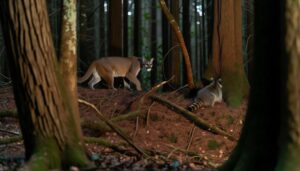Do Raccoons Eat Turtle Eggs and Impact Their Survival?
Yes, raccoons eat turtle eggs and are vital predators of these nests. Their omnivorous diet, keen sense of smell, and adaptability allow them to locate and consume turtle eggs effectively.
This predation particularly peaks during nesting seasons, and high raccoon population densities can increase the impact. Turtle nests are vulnerable to raccoon predation, which can severely reduce hatchling survival rates and disrupt local ecosystems.
Conservation strategies such as using mesh screens and educating communities are essential to mitigate this threat. Insights into these predator-prey dynamics reveal essential aspects of turtle conservation that are worth exploring further.
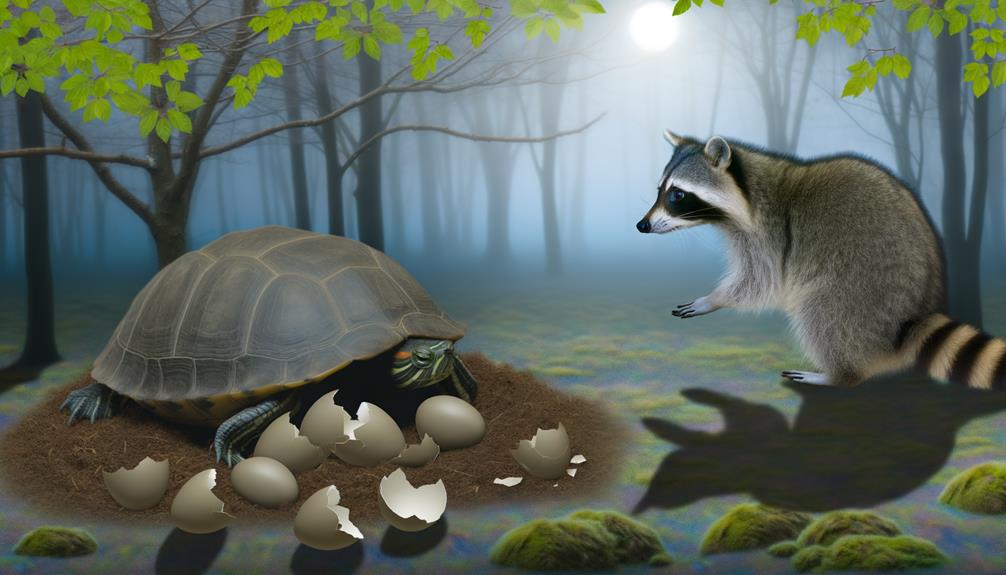
Key Takeaways
- Yes, raccoons eat turtle eggs and are significant predators of turtle nests.
- Raccoons use their keen sense of smell to locate and dig up turtle nests.
- Opportunistic predation by raccoons increases during turtle nesting seasons.
- High raccoon population density correlates with increased predation rates on turtle eggs.
- Effective mitigation includes using physical barriers like mesh screens to protect turtle nests from raccoons.
Raccoon Diet Overview
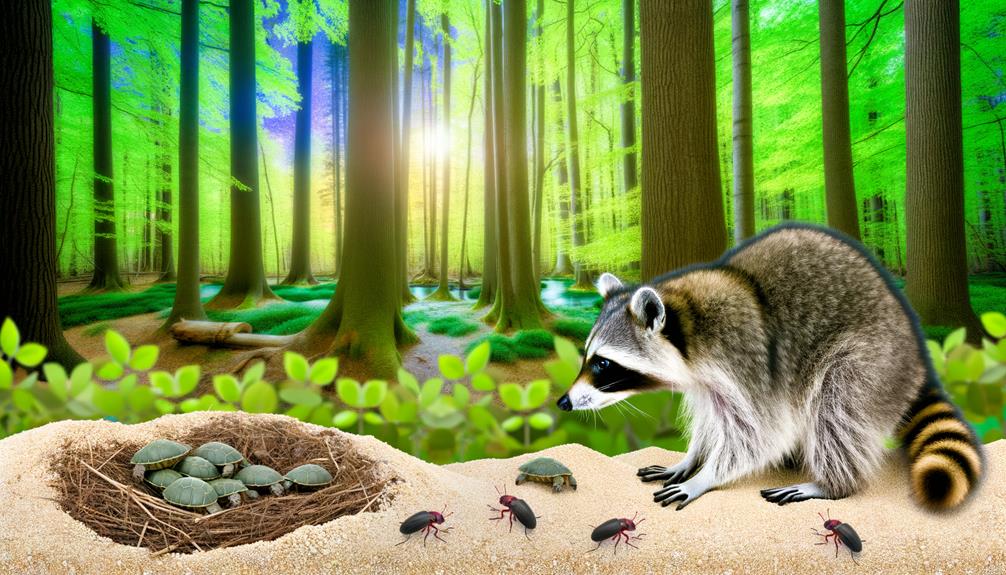
Raccoons (Procyon lotor) possess an omnivorous diet, which allows them to consume a diverse range of food items including fruits, insects, small mammals, and various forms of aquatic life. This dietary flexibility is an essential factor in their adaptability to various environments, from urban areas to dense forests.
Their foraging behavior is opportunistic; they exploit available food sources, which can vary seasonally and geographically. Additionally, raccoons exhibit complex food-handling skills, often washing their food in water if available. Their diet can include agricultural crops and human refuse, underscoring their role as both scavengers and active predators.
Understanding the breadth of raccoon dietary habits is fundamental for comprehending their ecological impact and interactions with other species within their habitats.
Turtle Egg Vulnerability
Turtle eggs face substantial threats from natural predators, with raccoons being one of the primary culprits.
The vulnerability of these eggs is further exacerbated by inadequate nesting site protection, which leaves them exposed to predation.
Understanding these factors is vital for developing effective conservation strategies.
Natural Predators' Threat
Among the various natural predators, raccoons pose a substantial threat to turtle eggs, exploiting their keen sense of smell and dexterous paws to locate and unearth nests. Their predation behavior is further facilitated by their adaptability to diverse environments, increasing their encounters with turtle nesting sites. This predatory pressure is compounded by other natural threats, such as foxes and birds, which also prey on turtle eggs. The collective impact of these predators notably reduces hatchling survival rates, posing a challenge to turtle conservation efforts.
| Predator | Method of Predation | Impact on Eggs |
|---|---|---|
| Raccoons | Digging and consumption | High |
| Foxes | Burrowing and consumption | Moderate to High |
| Birds | Pecking and consumption | Variable (species-dependent) |
Understanding these dynamics is essential for formulating effective conservation strategies.
Nesting Site Protection
Implementing effective nesting site protection measures is essential for mitigating the vulnerability of turtle eggs to predation and ensuring higher hatchling survival rates. Various strategies can be employed, including the use of physical barriers such as mesh screens or protective cages that prevent predators like raccoons from accessing nests.
Relocation of nests to safer areas and habitat management practices, such as reducing nearby vegetation that conceals predators, are also important. Additionally, community education and involvement can enhance protective efforts by increasing public awareness and participation in conservation activities.
Research indicates that these measures notably decrease egg predation rates, thereby contributing to the sustainability of turtle populations. Effective protection requires continuous monitoring and adaptation to address emerging threats and environmental changes.
Nesting Season Timelines
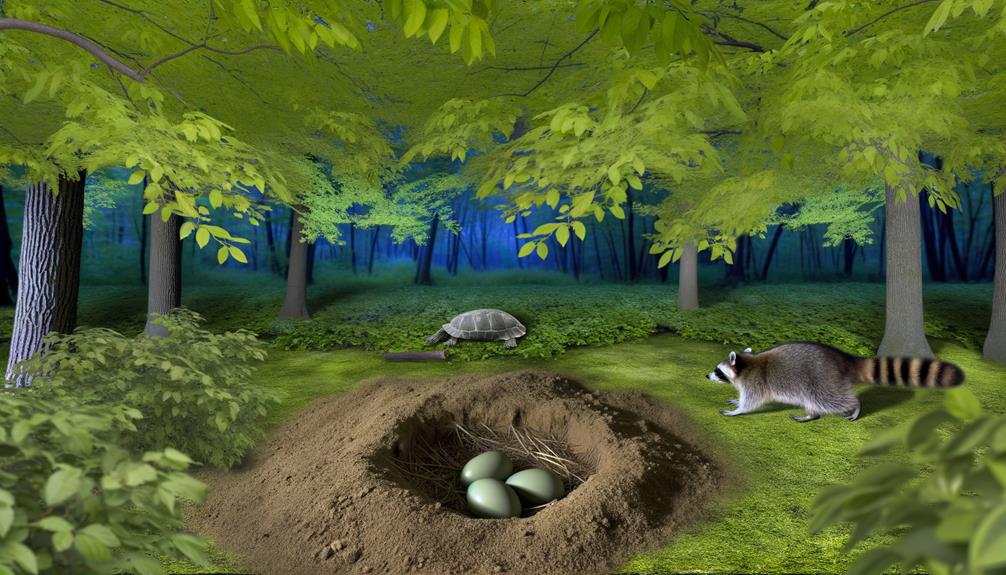
Nesting season timelines for turtles vary considerably depending on species and geographical location, typically occurring between late spring and early summer. Understanding these timelines is vital for conservation efforts and mitigating predation risks.
For example, sea turtles generally nest from May to August, while freshwater species like painted turtles nest from late May to mid-July.
Factors influencing nesting season include:
- Geographical Latitude: Turtles in warmer climates may nest earlier than those in cooler regions.
- Species-Specific Behaviors: Different species have evolved unique nesting periods to optimize survival.
- Environmental Conditions: Temperature, photoperiod, and food availability can influence nesting times.
Predation Behavior Analysis
Understanding the nesting season timelines provides a foundation for analyzing the predation behavior of raccoons and their impact on turtle egg survival. Raccoons exhibit opportunistic predation, exploiting turtle nests primarily during the nesting season when eggs are most vulnerable. Key behaviors include nocturnal foraging and utilizing their keen sense of smell to locate nests. Factors influencing predation rates include nest location, density of raccoon populations, and availability of alternative food sources.
| Factor | Influence on Predation |
|---|---|
| Nesting Season Timelines | Determines peak predation periods |
| Nest Location | Accessibility affects predation risk |
| Raccoon Population Density | Higher density increases predation |
| Alternative Food Sources | Availability may reduce egg predation |
| Nocturnal Foraging | Increases likelihood of nest discovery |
This multifaceted analysis underscores the complexity of raccoon predation behavior on turtle eggs.
Scientific Study Insights
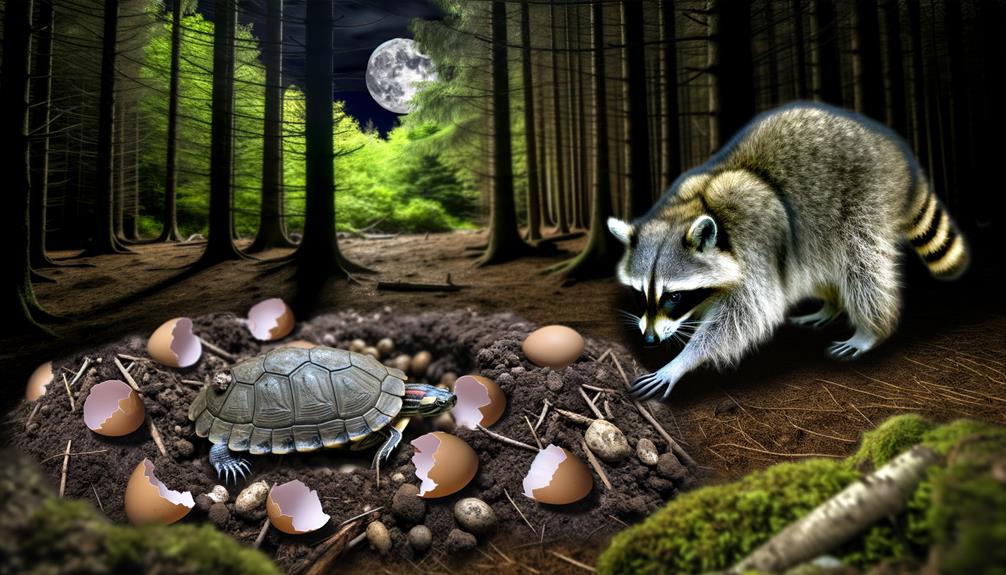
Scientific studies have elucidated key aspects of the predator-prey relationship dynamics between raccoons and turtles, particularly focusing on nesting site vulnerability.
Research indicates that raccoons frequently target turtle nests, greatly affecting egg survival rates.
This predation pressure has been shown to have profound implications for turtle population sustainability and conservation efforts.
Predator-Prey Relationship Dynamics
In ecosystems where raccoons and turtles coexist, the predation of turtle eggs by raccoons is an important factor influencing turtle population dynamics, as evidenced by numerous scientific studies. This predator-prey interaction can lead to significant impacts on turtle reproductive success and long-term population stability.
Research highlights several key insights into this dynamic:
- Predation Rates: Studies show that raccoons can destroy a large percentage of turtle nests, leading to high egg mortality rates.
- Behavioral Adaptations: Turtles may alter nesting behaviors, such as nest location and timing, in response to raccoon predation pressures.
- Ecological Consequences: The reduction in turtle hatchling numbers can affect ecosystem balance, as turtles play vital roles in their habitats.
Understanding these dynamics is essential for conservation strategies.
Nesting Site Vulnerability
Nesting site vulnerability to raccoon predation has been extensively documented, revealing key insights into how specific environmental factors and nest characteristics influence the likelihood of egg predation.
Studies indicate that nests situated in open, less vegetated areas are more prone to raccoon predation due to increased visibility and accessibility. Soil composition also plays a pivotal role; softer soils allow raccoons to excavate nests more easily. Additionally, proximity to water bodies and human activity zones can heighten predation risk, as these areas are frequented by raccoons.
Nest depth and the presence of olfactory cues further impact vulnerability. Collectively, these findings underscore the multifaceted nature of nesting site vulnerability, necessitating a thorough understanding of environmental and behavioral factors to mitigate predation risks effectively.
Impact on Turtle Population
Extensive research has demonstrated that raccoon predation impacts turtle populations by reducing hatchling survival rates. This predation has far-reaching implications for various turtle species, affecting their long-term sustainability.
Key scientific studies have highlighted several critical consequences:
- Reduced Recruitment: The loss of eggs and hatchlings diminishes the number of juveniles entering the population, thereby slowing population growth rates.
- Skewed Demographics: Predation biases sex ratios, as temperature-dependent sex determination in turtles means that the loss of clutches can disproportionately affect male or female numbers.
- Genetic Diversity Decline: Persistent egg predation limits genetic variation, which is crucial for adaptive responses to environmental changes.
These insights underline the necessity for targeted conservation strategies to mitigate raccoon impact on vulnerable turtle populations.
Ecological Impact
Predation of turtle eggs by raccoons disrupts local ecosystems by impacting turtle population dynamics and broader ecological interactions. This predation reduces hatchling survival rates, leading to long-term declines in turtle populations.
Turtles play an essential role in their habitats, such as maintaining healthy seagrass beds and contributing to nutrient cycling. A decrease in turtle numbers can, in turn, cause cascading effects throughout the ecosystem.
Additionally, raccoons, as opportunistic feeders, may experience population booms due to the abundance of turtle eggs, further intensifying the predation pressure. This imbalance can lead to increased competition among raccoons and other species, potentially destabilizing local biodiversity.
Understanding these interactions is crucial for a thorough evaluation of the ecological impact of raccoon predation on turtle eggs.
Conservation Efforts

To mitigate the adverse effects of raccoon predation on turtle eggs, various conservation efforts have been implemented to protect nesting sites and enhance turtle survival rates. These efforts are essential in ensuring the preservation of vulnerable turtle populations and include both direct and indirect interventions.
- Nest Screening: Physical barriers such as wire mesh screens are placed over nests to prevent raccoons from accessing the eggs.
- Habitat Management: Restoration and maintenance of natural habitats to support turtle nesting and discourage raccoon habitation near nesting sites.
- Monitoring and Research: Continuous monitoring of nesting sites and raccoon activity, combined with research on predator-prey dynamics to inform and refine conservation strategies.
These measures collectively contribute to the alleviation of raccoon impacts on turtle populations.
Mitigation Strategies
Building upon these conservation efforts, various mitigation strategies have been developed to reduce the impact of raccoon predation on turtle eggs. These strategies include the use of predator exclusion devices such as wire mesh cages placed over nesting sites, which physically prevent raccoons from accessing the eggs.
Habitat modifications, like removing attractants and altering raccoon access routes, also play an essential role. Public education initiatives aim to raise awareness about the importance of protecting turtle nests, encouraging community involvement in monitoring and reporting.
Moreover, some programs employ controlled culling of raccoon populations in critical nesting areas. Collectively, these strategies have shown promising results in safeguarding turtle nests from raccoon predation, thereby enhancing the survival rates of hatchlings.
Future Research Directions

In light of current mitigation strategies, future research directions should focus on refining and expanding these methods to further reduce raccoon predation on turtle eggs. Research should prioritize understanding raccoon behavior and ecology in relation to turtle nesting sites. Additionally, the development of more effective, non-invasive deterrents is important.
Potential research avenues include:
- Behavioral Studies: Investigate raccoon foraging patterns to identify key intervention points.
- Technological Innovations: Develop advanced, eco-friendly deterrents like automated barriers or scent-based repellents.
- Habitat Management: Explore habitat modifications that naturally deter raccoons without disrupting turtle nesting.
Such research is crucial to guarantee the long-term success of conservation efforts aimed at protecting vulnerable turtle populations from predation.
Conclusion
Raccoons' predation on turtle eggs greatly influences both species and their ecosystems.
What measures can effectively mitigate this impact, ensuring the survival of vulnerable turtle populations? Scientific studies highlight the importance of targeted conservation efforts and innovative mitigation strategies.
Future research must continue to explore ecological dynamics and adaptive behaviors, contributing to a thorough understanding of these interactions.
Addressing these challenges is essential for maintaining biodiversity and ecological balance within affected habitats.






